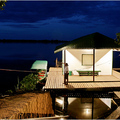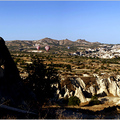
The Tibetan plateau is framed by a dining-car window. For luxury travelers, no place now seems too remote for a train trip.
AS the train rolled across the Tibetan countryside, I stared out into a harsh, bleak landscape. Tibetan nomads rode horses across seemingly endless grasslands dotted with small alpine lakes and ravines cut across snow-capped peaks. Tibetan traders hauling wheelbarrows piled with meat and barley walked a solitary road alongside the train route.
Inside the new Tibet train, which opened last summer and climbs to 16,000 feet while linking Lhasa to other parts of western China , passengers luxuriated in creature comforts. Groups of Chinese travelers played cards in their plush reclining chairs and four-bunk cabins. Even the waitresses, normally surly on Chinese trains, seemed to have attended remedial charm school — they laughed and even bowed slightly as they handed out plates of noodles and spicy Sichuan sautéed tofu. And next year, the trip will become even more luxurious; the company Rail Partners plans to open a high-end route to Lhasa that will include 24-hour butler service and flat-screen TVs.
Even in remote Tibet, it seems, the era of luxury train travel has returned, albeit to areas where it never before existed. Many nations are reinvesting in their train systems since flying has become more uncomfortable and far less luxurious in the age of terrorism and low-cost airlines; this summer has produced more stories of flight delays. And with growing interest in airplanes’ carbon footprint, some travelers also are realizing trains may be more environmentally friendly.
In a world of cramped and unpleasant planes, trains actually may be the last respite of luxury. Sensing this demand, luxury travel companies like Orient-Express have invested in restoring the world’s most famous train routes. And travelers are responding by packing new trains. In China, tickets for the Tibet route are so coveted that a black market has sprung up at some stations, and I had to pay a scalper four times face value to get one of the coveted berths when I traveled last August.
Much of the new boom in luxury trains has come in Asia , which has a generation of newly wealthy tourists eager to see their own countries. Vietnam has upgraded the train system running the length of the country. India’s rail system long has knitted the nation together, but in recent years it has moved beyond its utilitarian purpose. The upscale Taj hotel group, for one, has helped roll out the Deccan Odyssey, which rumbles from Mumbai to Goa and Pune. The Deccan’s interiors resemble maharajas’ palaces, with overstuffed sofas and rich wood walls, and stewards onboard monitor their guests’ every need. A similar luxury train, the Palace on Wheels, runs from Delhi through the tourist triangle of Jaipur and Agra, and the Indian government is considering another luxury route across the entire country.
Orient-Express pioneered the new age of upscale Asian trains, by creating the Eastern & Oriental Express between Singapore and Bangkok in the early ’90s. That train simulates the grand, formal Asian trains of the early 20th century, with cherry paneling, silk curtains and cabins complete with Bulgari toiletries.
The Eastern & Oriental benefits from innate Thai hospitality, which can make even a train breakdown endurable. On one recent trip heading south from Bangkok, on a normal Thai train, the carriage shuddered to a halt just before the next station, leaving my fellow passengers and me staring out the window at rice fields and an occasional water buffalo. The air-conditioning started to falter — not a welcome development on a 100-degree day. Still, while the engineers tried to fix the power, members of the cabin staff distributed bottles of water and boxes of icy fresh papaya and pineapple.
Many of these Asian trains pattern themselves after cruise ships and include amenities far beyond traditional railroads. The Deccan includes a spa room, where you can sample local ayurvedic massage and steam baths as the train rolls on. Other new trains include boutiques and Internet access.
European and African nations also have recognized the demand for luxury rail trips. Competing with South Africa’s long-running Blue Train between Cape Town and Pretoria, a formal experience where men don jackets for dinner in the train restaurant, the South African businessman Rohan Vos began Rovos Rail. Using restored carriages from as far back as 1911, Rovos offers itineraries across southern Africa. Even small, isolated Eritrea has revamped its narrow-gauge railway, dating from the Italian colonial era, so it can run charters. It ascends through impossibly steep passes rising from Asmara, the capital.
As in Asia, Orient-Express helped rebuild the European luxury rail market by restoring 1920s coaches and trying to re-create the most famous train in history, the Orient Express route to Istanbul, which inspired mystery novels and films. The new-old train comes complete with afternoon tea and snaking curves through Austrian mountain passes. No microwaved burgers or other typical train fare here: At meals on Orient-Express’s trains, guests can dig into beluga caviar, white truffle risotto and roasted Alaskan white king salmon.
GW Travel, a British travel company, this year began a luxury trans-Siberian service from Moscow to Vladivostok. The service barely resembles the trip I once took on an old Siberian spur route, where cabin attendants screamed at passengers in the middle of night and, during an hours-long train stop, we waited outside in a dark, decrepit border town as traders tried to sell us ratty Mongolian cashmere sweaters and moldering fruit. Instead, GW’s train features cabins with flat-screen TVs and DVD players.
Even long-maligned Amtrak is getting into the act, and plans to introduce restored vintage cars on several long cross-country and Eastern Seaboard routes.
Working with Grand Luxe Rail Journeys, Amtrak is equipping the cars with lounges that feature live piano music and upscale dining cabins with uniformed waiters. The restored cars will be connected to regular Amtrak trains, but passengers from other cars will not be able to enter the upscale section.
Some things, apparently, never change.
VISITOR INFORMATION
The most comprehensive Web site about international train travel is www.seat61.com. It’s run by a former employee of British train companies and offers route details, extensive information about how to book in many nations and detailed histories of some of the world’s most famous trains.
For organized all-inclusive luxury rail trips through Europe, try the tour operator Great Rail Journeys (www.greatrail.com). These trips normally include train tickets, guides and accommodations for wherever you stop, though this can vary. A 10-day tour of the Tyrol starts at £795 (about $1,645 at $2.07 to the pound), and an 11-day tour through Spain and on to Morocco by ferry starts at £1,750.
Or, you can book luxury trains more directly. For more information about the Deccan, go to www.deccan-odyssey.com, and for more information about the Eastern & Oriental Express and the restored Orient Express see www.orient-express.com. (The Orient Express, now called the Venice Simplon-Orient-Express, primarily runs to Venice, but it offers occasional special trips to Istanbul.) For more information about the upscale trans-Siberian route go to www.gwtravel.co.uk. Twin shares on the trans-Siberian route next year start at £5,495. Blue Train information is available at www.bluetrain.co.za, and Rovos information is at www.rovos.com. Information on Amtrak’s new upscale service is available at www.grandluxerail.com. Berths start at $789 a person.
For train bookings in Thailand other than on the Eastern & Oriental, see www.thaifocus.com. An interesting side train trip is to Kanchanaburi, in western Thailand, where museums commemorate the World War II railway link with Burma built by Thai laborers and Allied prisoners of war, which inspired “The Bridge on the River Kwai.”





